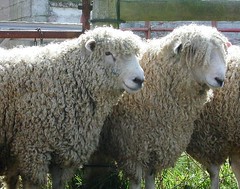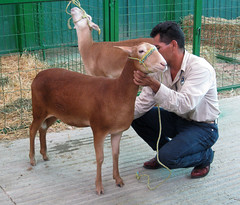Counting sheep
Sheep breeds
It is difficult to know how many breeds of sheep there are in the world, as only developed countries usually maintain breed registries. However, it is believed that there are more breeds of sheep than breeds of any other livestock
species, with the exception of poultry. Worldwide, it is estimated that there are more than 1000 distinct sheep breeds. There are more than 60 breeds in the United States alone.
Sheep come in all different sizes, shapes, and colors, and there are many ways to classify sheep: according to their primary purpose
(meat, milk, or wool), the type of coat they have or fibers they grow (fine, medium,
long or carpet wool; or hair), the color of their faces (black,
white, red, or moddled), and/or by specific physical or production
characteristics.
Fine wool sheep
Fine wool sheep produce wool fibers with a very small fiber
diameter, usually 20 microns or less. A micron is one-millionth of a meter. Fine wool sheep account for more than 50 percent of the world's sheep population.
Found throughout Australia, South Africa, South America, and
the western United States, most sheep of this type are Merino or trace their ancestry to the Merino.
The Rambouillet, related to the Merino, is the most common breed
of sheep in the U.S., especially the western states where the
majority of sheep in the U.S. can still be found. Fine wool sheep
are best adapted to arid and semi-arid regions. Besides being known for their high quality fine wool, they are known
for their longevity and strong flocking instinct.
Long wool sheep
Long wool sheep produce long-stapled wool with a large fiber
diameter, usually greater than 30 microns. Long wool sheep are
best adapted to cool, high rainfall areas with abundant forage.
They are commonly raised in England, Scotland, New Zealand, and
the Falkland Islands. In the U.S., the fleeces from the long wool
breeds are popular among niche marketers and hand spinners. Popular long wool breeds include Border Leicester, Coopworth, Cotswold, Leicester Longwool, Lincoln, and Romney.
Medium wool meat sheep
Meat or "mutton-type" sheep produce wool, mostly
medium (or long), but are raised more for their meat qualities.
Medium wool sheep account for about 15 percent of the world's
sheep population. The most popular meat breeds in the U.S. are
Cheviot, Dorset, Hampshire, Shropshire, Southdown, and Suffolk.
Carpet wool sheep
The coarsest grade of wool (usually over 38 microns) is used
in the manufacture of carpets; hence, the name. Carpet wool breeds are usually
double-coated, with a coarse long outer coat for protection against
the elements and a short, finer undecoat. They are generally adapted to extreme environments.
Carpet wool breeds found in the U.S. include Icelandic, Karakul,
Navajo Churro, and Scottish Blackface.
Hair Sheep
Some breeds lack wool and are covered with hair instead, like
their wild ancestors. Some hair sheep have pure hair coats, whereas
others have coats that contain a mixture of hair and wool fibers
that shed naturally. Hair sheep are found mostly in Africa and
the Caribbean, but are also raised in temperate climates, such
as the U.S. and Canada.
Hair sheep account for about 10 percent of the world's sheep population
and are the fastest growing segment of the American sheep industry.
In fact, the Katahdin, an American breed of hair sheep, now leads all US sheep breeds in registration numbers and transfers. Interest in hair sheep is also developing in other countries, including Australia and Mexico.
Fat-tailed sheep
Fat tailed or fat-rumped sheep are so-named because they can
store large amounts of fat in their tail and rump.
Fat-tailed sheep are found mostly in the extreme environments in Africa, the Middle East, and Asia. They grow wool,
but are raised primarily for their meat or milk. Fat-tailed
sheep comprise 25 percent of the world's sheep population. The only fat-tailed sheep in the U.S. is the Karakul. The fat-tail was bred out of the Tunis. The Awassi, a fat-tail sheep from the Middle East was recently introduced to the U.S. via semen and embryos.
Short or rat-tailed breeds
Short or rat-tailed breeds originate primarily from Scandinavia
and Northern Europe. Their tails are thin and free of wool and
do not need docked. They tend to be prolific. Examples
of these breeds include Finn Sheep, Romanov, East Friesian, Shetland,
Icelandic, and Soay.
Prolific breeds
Some sheep breeds are known for their prolificacy or high birth rates. Some were found to be naturally prolific, whereas selection has resulted in the high prolificacy of others. The first prolific breed identified was the Finnish Landrace (Finn). The Romanov was the next breed identified as being highly fertile. The Booroola Merino is the most recently discovered prolific breed. However, it differs from the Finn and Romanov, in that its prolificacy is due to a single gene. The prolificacy of the Chinese Hu breed is also believed to be the result of a single gene. In prolific breeds, litter size usually exceeds 2.5 lambs per birth.
Primitive breeds
Primitive breeds have developed with minimal human selection
pressure. They typically possess considerable genetic variation between
members, but share characteristics indicative of a breed. A primitive
breed will typically retain survival characteristics that favor
production (and survival) with minimal human inputs.
Consistency among the products produced by the breed is somewhat
lacking, but they are an important source of genetic variation
that may not exist anywhere else. Many primitive breeds live in
isolated mountain regions or on islands. Like some species of
wildlife, many are endangered. Fortunately conservation efforts
are underway to preserve these important genetic resources. Some producers niche market the meat from primitive breeds.
<== KINDS OF SHEEP






